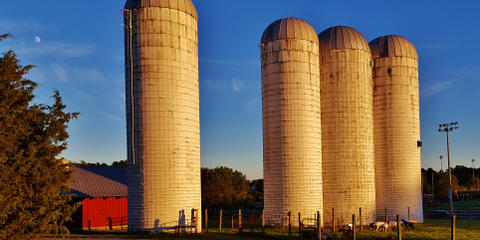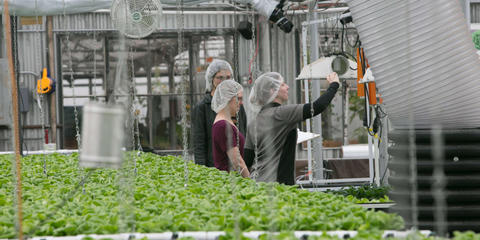Federal funding programs are under review as of 1/27/25. We'll make updates as new info is released.
Marketing assistance loans (MALs) and loan deficiency payments (LDPs) are marketing tools available during harvest or shearing.
Marketing assistance loans provide interim financing at harvest time to help agricultural producers meet cash flow needs without having to sell their commodities when market prices are typically at harvest-time lows. This enables producers to delay selling the commodity until more favorable market conditions emerge. Storing production at harvest (or at shearing for wool and mohair) allows more orderly commodity marketing throughout the year.
Producers may obtain MALs or receive LDPs on all or part of their eligible production anytime during the loan availability period which runs from when the commodity is normally harvested (or sheared) until January 31st, March 31st or May 31st (depending on the commodity).
Enterprises
Eligibility
To be eligible for a MAL or LDP, a producer must:
Comply with conservation and wetland protection requirements;
Submit an acreage report for all cropland on all farms as applicable;
Have and retain beneficial interest in the commodity until the MAL is repaid or CCC takes title to the commodity; and
Meet adjusted gross income limitations (described in a later section).
Eligible Commodities
Eligible commodities include wheat, corn, grain sorghum, barley, oats, upland cotton, extra-long staple cotton (eligible for MAL only), long grain rice, medium grain rice, soybeans, other oilseeds (including sunflower seed, rapeseed, canola, safflower, flaxseed, mustard seed, crambe and sesame seed), dry peas, lentils, small chickpeas, large chickpeas, graded and nongraded wool, mohair, unshorn pelts (eligible for LDP only), honey and peanuts. Commodities harvested as other than grain may also be eligible for a LDP. The commodity must:
Have been produced, mechanically harvested or shorn from live animals by an eligible producer and be in storable condition;
Be merchantable for food, feed or other uses, as determined by CCC; and
Meet specific CCC minimum grade and quality standards for MALs.
Terms
Interest:
The interest rate charged on a commodity loan is set at one percentage point above CCC’s cost of borrowing on Jan. 1.
Accrued interest is the amount of interest that accumulates while a loan is outstanding, starting with the day the loan is made. Accrued interest is calculated by multiplying: (i) the applicable interest rate times, (ii) the ratio of the number of days under loan (starting with the initial day and continuing through the day prior to the day a loan is repaid) to the number of days in a year (i.e., 365) times, (iii) the loan principal.
Loan Repayment
MALs mature on the last day of the ninth calendar month following the month in which the MAL is approved, except all seed cotton loans mature on May 31 the year following when the cotton was planted. A producer may repay an outstanding MAL:
Before maturity period by repaying the MAL, or;
Upon maturity by settling or forfeiting the commodity to CCC. The commodity is transferred to CCC to repay the loan. For all loan-eligible commodities except extra-long staple (ELS) cotton or any recourse loan, a producer may repay a MAL any time during the loan period at the lesser of the:
Loan rate plus accrued interest and other charges, or;
Alternative loan repayment rate as determined by CCC. For wheat, feed grains and oilseeds, the CCC determined alternative loan repayment rate is often referred to as the posted county price (PCP). PCPs are established and available at each local USDA Service Center. PCPs are based upon market prices at appropriate U.S. terminal markets, adjusted to reflect quality and location. PCPs are announced daily for wheat, feed grains, soybeans, canola, flaxseed and sunflower seed, and weekly for other oilseeds. For peanuts, CCC determines national posted prices (NPP) for four types of peanuts and announces them weekly. For dry peas and lentils, CCC determines and announces regional posted prices weekly. For wool and large and small chickpeas, CCC determines and announces an NPP weekly. For honey, CCC determines and announces the national survey price monthly. For long and medium grain rice and upland cotton, a producer may repay a MAL any time during the loan period at the lesser of the:
Loan rate plus accrued interest and other charges, or;
Adjusted world price (AWP). The AWP is the prevailing world market price adjusted to U.S. quality and location. Separate AWPs for long grain, medium grain rice and upland cotton are announced weekly.
Application Instructions
Contact your local FSA office to apply.
Related Programs

Farm Storage Facility Loan Program (FSFL)
Farm Service Agency
- Loan
- Infrastructure
- Equipment
- Storage
- Lighting
- Delivery Vehicle
- National
- Oilseeds
- Peanuts
- Pulse Crops
- Hay
- Honey
- Biomass
- Fruits
- Vegetables
- Floriculture
- Hops
- Maple Sap
- Milk
- Cheese
- Yogurt
- Butter
- Eggs
- Rye
- Aquaculture
- Poultry
- Livestock
- Grains

A Climate-Smart Strategy for the Michigan Foodshed
Star of the West Milling Company, U.S. Department of Agriculture
- Grant
- Climate-Smart
- Beginning Farmers
- Women
- MI
- Wheat
- Dried Beans
- Soybeans

ACRE3 Agricultural Energy Efficiency
Colorado Department of Agriculture
- Grant
- Cost Share
- Loan
- Alternative Energy
- Conservation
- Irrigation
- Storage
- Greenhouse
- CO
- Any

ACRE3 Irrigation Hydropower Programs
Colorado Department of Agriculture
- Grant
- Cost Share
- Loan
- Hydro Power
- Alternative Energy
- Irrigation
- Conservation
- Water Management
- Equipment
- CO
- Any
Details
Organization
Financial Instrument
Loan
Updated December 4, 2025
Image Credit: U.S. Department of Agriculture
This information was gathered from public sources. Ambrook is not responsible for or able to affect the results of any financial programs listed, nor are they responsible for any incorrect information that is listed or is on the hyperlinked external sites. All information is subject to change.
Explore hundreds more programs on Ambrook.
